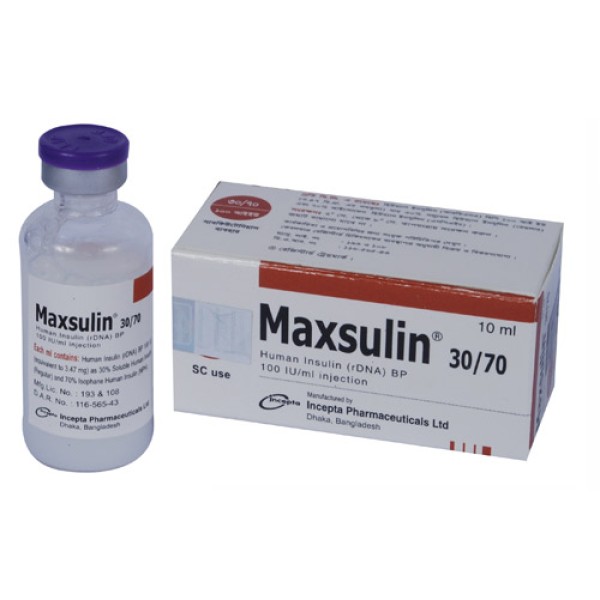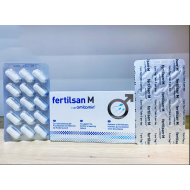
- Stock: In Stock
- Brand: Incepta Pharmaceuticals
- Product ID: Insulin Human [rDNA] + Isophane Insulin Human
100% Secure Payment

Maxsulin 30/70 injection 100 IU: Each ml suspension contains Human Insulin (rDNA) BP 100 IU (equivalent to 3.47 mg) as 30% soluble Insulin (Regular) and 70% Isophane Insulin (NPH).
Description
The blood glucose lowering effect of Insulin is due to the facilitated uptake of glucose following binding of Insulin to receptors on muscle and fat cells and to the simultaneous inhibition of glucose output from the liver.
Indications
Treatment of diabetes mellitus. Furthermore indicated for the initial stabilisation of diabetes, during treatment of diabetic ketoacidosis and the hyperosmolar non ketotic syndrome, and during stress situations such as severe infections and major surgery in diabetic patients.
Instructions to be given to the patient
Before injecting this Insulin,
1. Disinfect the rubber stopper.
2. If suspension, roll the vial between the palms of the hands until the liquid is uniformly white and cloudy.
3. Draw into the syringe the same amount of air as the dose of insulin to be injected.
4. Inject the air into the vial.
5. Turn the vial and syringe upside down and draw the correct insulin dose into the syringe. Withdraw the needle from vial and expel the air from the syringe and check that the dose is correct.
6. Inject immediately.
Dosage & Administration
Dosage is individualized and determined by the physician in accordance with the needs of the patient.
The average range of total daily Insulin requirement for maintenance therapy in type 1 diabetic patients lies between 0.5 and 1.0 IU/kg. However, in pre-pubertal children it usually varies from 0.7 to 1.0 IU/kg, but can be much lower during the period of partial remission. In Insulin resistance, e.g. during puberty or due to obesity, the daily Insulin requirement may be substantially higher.
Initial dosages for type 2 diabetic patients are often lower, e.g. 0.3 to 0.6 IU/kg/day.
An injection should be followed by a meal or snack containing carbohydrates within 30 minutes.
The preparations are administered subcutaneously in the thigh or abdominal wall. A subcutaneous injection
into the abdominal wall results in a faster absorption than from other injection sites.
Insulin suspensions are never to be administered intravenously.
Side Effects
Hypoglycaemia, severe hypoglycaemia may lead to unconsciousness and/or convulsions and may result in temporary or permanent impairment of brain function or even death.
Symptoms of generalised hypersensitivity may include generalised skin rash, itching, sweating, gastrointestinal upset, angioneurotic oedema, difficulties in breathing, palpitation and reduction in blood pressure.
Fast improvement in blood glucose control may be associated with a condition termed acute painful neuropathy, which is usually reversible. Lipodystrophy may occur at the injection site as a consequence of failure to rotate injection sites within an area.
Injection site reactions (redness, swelling, itching, pain and haematoma at the injection site) may occur during treatment with Insulin. Most reactions are transitory and disappear during continued treatment. Oedema may occur upon initiation of Insulin therapy. These symptoms are usually of transitory nature.
Precautions
Inadequate dosing or discontinuation of treatment, especially in type 1 diabetes, may lead to hyperglycaemia. In type 1 diabetes, untreated hyperglycaemic events eventually leads to diabetic ketoacidosis which is potentially lethal.
Hypoglycaemia may occur if the Insulin dose is too high in relation to the Insulin requirement. If an adjustment is needed, it may occur with the first dose or during the first several weeks or months.
Patients whose blood glucose control is greatly improved e.g. by intensified Insulin therapy, may experience a change in their usual warning symptoms of hypoglycaemia and should be advised accordingly.
Use in Pregnancy & Lactation
There are no restrictions on the treatment of diabetes with Insulin during pregnancy as Insulin does not pass the placental barrier.
There are no restrictions on the treatment of diabetes with Insulin during lactation, as Insulin treatment of the nursing mother involves no risk to the baby. However, the Insulin dosage, diet or both may need to be reduced.
Over Dose
Insulins have no specific overdose definitions. However, hypoglycaemia may develop over sequential stages:
Mild hypoglycaemic episodes can be treated by oral administration of glucose or sugary products. It is therefore recommended that the diabetic patient constantly carry some sugar lumps, sweets, biscuits or sugary fruit juice.
Severe hypoglycaemic episodes, where the patient has become unconscious, can be treated by glucagon (0.5 to 1 mg) given intramuscularly or subcutaneously. Glucose must also be given i.v, if the patient does not respond to glucagon within 10 to 15 minutes.
Upon regaining consciousness administration of oral carbohydrate is recommended for the patient in order to prevent relapse.
Storage
Store at 2°C to 8°C in a refrigerator. Do not freeze. Protect from light.



























%20Pvt.%20Ltd./Movicol-Oral-Powder-190x190.jpg)
